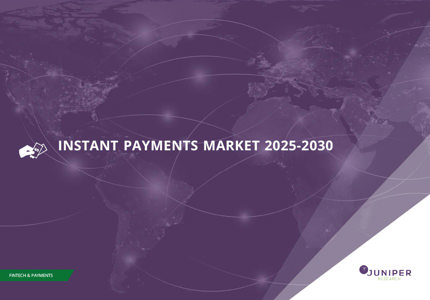Will Project Keystone Unlock the Potential of Instant Payments?
While many headlines in payments focus on consumer behaviour, often the most impactful changes and developments are related to infrastructure capabilities. This is true within instant payments (also known as real-time payments), as while it is growing rapidly, it has strong potential, if infrastructure can be improved and interoperability challenges can be solved.
One such infrastructure change is a forthcoming tool called Project Keystone. The Bank of International Settlement’s (BIS) Innovation Hub, in collaboration with the Bank of England (BoE), announced the launch of the prototype of Project Keystone; a data analyst tool. This is an off-the-shelf analytics tool for the data derived from the ISO 20022 payments messaging standards. ISO 20022 is a financial messaging standard prepared by the International Organization for Standardization, with the aim of enabling communication interoperability between financial institutions (FIs). It achieves this by providing a consistent format and protocol to all financial services providers.
A key feature of this standard is a messaging language designed to contain more transaction data then previous standards, as well as being better suited for machine reading. This allows far greater automation and provides stakeholders with better visibility over transactions. This automation and additional data are vital for the implementation of additional services such as real-time fraud prevention and automatic receipt creation, which are a significant selling point in ISO 20022’s adoption.
In its current form, Project Keystone converts ISO 20022 messages into a dashboard for intraday liquidity, network risk and macro ‘nowcasting’. The project combines a data transformation platform with pre-defined modules so payment system operators can run ad hoc analysis without the need for custom build. A key aspect of the prototype is its liquidity monitoring suite; tracking the inflow and outflow and the maximum intraday net debit position of each participant. This will allow it to be gauged whether a bank is holding enough liquidity in a period of stress. The toolkit also flags delayed payments against historical norms and renders a network view; showing the most active nodes and how tightly participants are interlinked.
The project is explicitly targeted at wholesale real-time gross settlement (RTGS). As the overwhelming majority of these transactions are between FIs and corporates, the prototype can restrict access to any personal message while still producing analytical outputs. This enables liquidity and macro-oriented insights without breaching confidentiality. The project also has messaging alignment checks built in with the aim of encouraging harmonisation and reducing the variation in messaging standards across different jurisdictions.
Project Keystone is coming at a critical time, as ISO 20022 adoption reaches 78% of payment system operations. This also coincides with related regulatory changes, such as the European instant payments mandate. This mandate does not require the adoption of ISO 20022 specifically, but as the majority of instant payment rails in the EU and the UK operate using ISO 20022, it will see an uptick in the number of payment service providers using the messaging standard. This will see the number of instant payments being made more than double over the coming years, as shown in the below figure - as well as lead to a much greater demand for tools that can offer additional utility for instant payments.
Total Global Value of Instant Payment B2B Transactions ($m), 2025 vs. 2028

Source: Juniper Research
Project Keystone is still only in the prototype stage but is showing great early promise. If it works as advertised, it will offer payment system operators far greater visibility over the health of their payments ecosystem, as well as indicators of issues such as a lack of liquidity. Central banks that use RTGS and operate payment rails on ISO 20022 must look to utilise the insights provided by analysis tools such as Project Keystone in order to maximise the benefit of updating legacy systems to ISO 20022. Institutions yet to update their systems must also consider analysis tools as an inherent part of moving to ISO 20022 when making a decision on whether to change systems.
Thoughts must also be put towards what future versions of Project Keystone look like. BIS and BoE say that future builds of the toolkit will focus on expanding the number of pre-built analytic use cases covered. Information such as Bank Identifier Codes and Legal Entity Identifiers to allow for the tracking of which entities are involved in which transactions have been proposed. This would be particularly useful when checking potential warnings about poor market health, as this would not just identify its existence, but be able to pinpoint where the issue may be coming from.
For all the positivity around Project Keystone, it is worth stressing that it is only in the prototype stage. It has not been tested in the real world at scale, which will be an important hurdle to clear. There is also a question of what the limitations are of this toolkit. Can its use be taken beyond monitoring by payment systems operators? Will it be usable to provide advance transaction data to FIs and payment service providers (PSPs), or is its usefulness limited to governance? These are important questions to be considered before it is fully launched.
In the short- to medium-term, Juniper Research expects its implementation to be kept strictly to its originally intended role. However, businesses and PSPs will be very interested in utilising the information ISO 20022’s additional data can provide, and as such there will be demand for similar tools for FIs, PSPs and merchants. Juniper Research recommends payment technology providers build toolkits and dashboards that will allow clients to extract insights from ISO 20022 transaction data and can integrate with additional services that can use that data. This will solve challenges for stakeholders throughout the ecosystem; boosting instant payments in the longer term.
As a Senior Research Analyst, Michael delivers in-depth insights into the fast-evolving worlds of digital identity and payments. His recent work spans critical topics such as B2B Payments, Chargeback Mangement, and Digital Wallets; helping industry leaders navigate change and identify new opportunities.
Latest research, whitepapers & press releases
-
 ReportDecember 2025
ReportDecember 2025AI Agents for Customer Experience Platforms Market: 2025-2030
Our comprehensive AI Agents for Customer Experience Platforms research suite comprises detailed assessment of a market that is set to disrupt mobile communications. It provides stakeholders with insight into the key opportunities within the AI agents for customer experience platforms market over the next two years.
VIEW -
 ReportDecember 2025Fintech & Payments
ReportDecember 2025Fintech & PaymentseCommerce Fraud Prevention Market: 2025-2030
Our eCommerce Fraud Prevention research suite provides a detailed and insightful analysis of this evolving market; enabling stakeholders from financial institutions, law enforcement agencies, regulatory bodies and technology vendors to understand future growth, key trends, and the competitive environment.
VIEW -
 ReportNovember 2025Telecoms & Connectivity
ReportNovember 2025Telecoms & ConnectivityeSIMs & iSIMs Market: 2025-2030
Juniper Research’s eSIMs and iSIMs research suite offers insightful analysis of a market set to experience significant growth in the next five years. The research suite provides mobile network operators (MNOs), original equipment manufacturers (OEMs), and eSIM management and platforms vendors with intelligence on how to capitalise on the market growth, and guidance on how eSIM-only devices and sensors, SGP.42, in-factory provisioning, and iSIMs will change the competitive landscape.
VIEW -
 ReportNovember 2025Fintech & Payments
ReportNovember 2025Fintech & PaymentsModern Card Issuing Platforms Market: 2025-2030
Our Modern Card Issuing Platforms Market research suite provides a detailed and insightful analysis of this evolving market; enabling stakeholders from banks, financial institutions, fintech companies, and technology vendors to understand future growth, key trends, and the competitive environment.
VIEW -
 ReportNovember 2025Fintech & Payments
ReportNovember 2025Fintech & PaymentsDigital Wallets Market: 2025-2030
Our digital wallets research suite provides detailed analysis of this rapidly changing market; allowing digital wallet providers to gain an understanding of key payment trends and challenges, potential growth opportunities, and the competitive environment.
VIEW -
 ReportOctober 2025Fintech & Payments
ReportOctober 2025Fintech & PaymentsDigital Identity Market: 2025-2030
Juniper Research’s Digital Identity research suite provides a comprehensive and insightful analysis of this market; enabling stakeholders, including digital identity platform providers, digital identity verification providers, government agencies, banks, and many others, to understand future growth, key trends, and the competitive environment.
VIEW
-
 WhitepaperDecember 2025Telecoms & Connectivity
WhitepaperDecember 2025Telecoms & ConnectivityHuman + AI: Drivers of Customer Experience AI Agents in 2026
Our complimentary whitepaper, Human + AI: Drivers of Customer Experience AI Agents in 2026, examines the key drivers of the AI agents for customer experience platforms market in 2025.
VIEW -
 WhitepaperDecember 2025Fintech & Payments
WhitepaperDecember 2025Fintech & PaymentsBeyond Chargebacks: The True Cost of Fraud for Digital Commerce
Our complimentary whitepaper, Beyond Chargebacks: The True Cost of Fraud for Digital Commerce, examines the state of the eCommerce fraud prevention market; considering the impact of evolving digital fraud strategies, including key trends such as identity theft, account takeovers, chargebacks, policy abuse and friendly fraud.
VIEW -
 WhitepaperNovember 2025Telecoms & Connectivity
WhitepaperNovember 2025Telecoms & ConnectivityeSIM-only Devices: The Impact on Operators, Consumers, and IoT
Our complimentary whitepaper, eSIM-only Devices: The Impact on Operators, Consumers, and IoT, explores the challenges and opportunities for the three segments, with a particular focus on eSIM-only smartphones and SGP.42.
VIEW -
 WhitepaperNovember 2025Fintech & Payments
WhitepaperNovember 2025Fintech & PaymentsUnlocking the Next Stage of Growth for Modern Card Issuing Platforms
This free whitepaper analyses key trends shaping the modern card issuing space, and the ways in which modern card issuing platforms can capture growth.
VIEW -
 WhitepaperNovember 2025Fintech & Payments
WhitepaperNovember 2025Fintech & PaymentsTop 10 Fintech & Payments Trends 2026
Fintech is evolving fast. From stablecoins to agentic AI, our annual guide reveals the shifts redefining payments, digital identity, and the future of money in 2026. Download your copy today.
VIEW -
 WhitepaperNovember 2025Fintech & Payments
WhitepaperNovember 2025Fintech & PaymentsDigital Wallets: Empowering Financial Inclusivity
Our complimentary whitepaper, Digital Wallets: Empowering Financial Inclusivity, examines the state of the digital wallets market; considering the impact of digital wallets on different geographies, how they are shaping the modern payments landscape through lower transaction fees and promoting financial inclusivity for underbanked populations, and how they are competing with established payment methods.
VIEW
-
IoT & Emerging Technology
Juniper Research Unveils Top 10 Emerging Tech Trends to Watch in 2026
January 2026 -
Fintech & Payments
Digital Identity App Usage to Hit 6.2 Billion by 2030, Driven by Shift to Decentralised Models
December 2025 -
Telecoms & Connectivity
Travel eSIM Margins Under Pressure as Revenue per Gigabyte Falls 10% Globally in Two Years
December 2025 -
Telecoms & Connectivity
AI Agents to Power 1,000% More Customer Interactions for Enterprises Globally by 2027
December 2025 -
IoT & Emerging Technology
Global D2C Revenue Set for $370 Million Surge, But Satellite Operators Should Not Chase Full MNO Status
December 2025 -
Fintech & Payments
Digital Goods Fraud to Cost eCommerce Merchants $27 Billion Globally by 2030 as AI Tools Accelerate Attacks
December 2025





















